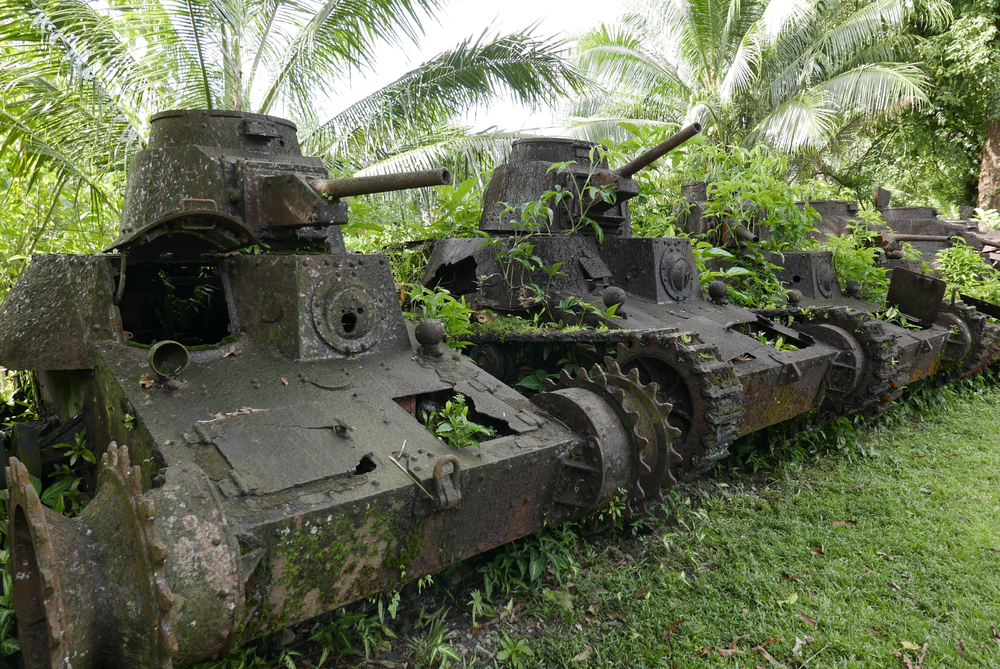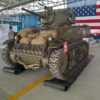When we think of military vehicles, certain iconic machines often come to mind, but there are many that played pivotal roles yet remain largely forgotten. From unique designs to groundbreaking innovations, these vehicles deserve more recognition for their contributions to history. Here’s a look at 15 historic military vehicles that may not be household names, but certainly earned their place in military history.
Contents
Matilda II Infantry Tank (UK)

The Matilda II was a heavily armored infantry tank used in the early stages of WWII. Its thick armor made it nearly invulnerable to most enemy anti-tank weapons of the time. Despite its slow speed, it played a critical role during the North African campaign, providing essential support for British forces. The Matilda II was also well-armed with a 2-pounder (40 mm) anti-tank gun, making it a formidable opponent in early war battles.
T-28 Super Heavy Tank (USA)

The T-28 was designed to penetrate the strongest enemy fortifications, making it one of the largest tanks ever built by the U.S. Weighing over 95 tons, its thick armor was nearly impervious to most artillery of the time. Although it was never used in combat due to its massive size and limited mobility, the T-28 showcased the extremes of tank development in the era of fortified combat.
M18 Hellcat (USA)

The M18 Hellcat was the fastest U.S. tank destroyer of WWII, capable of reaching speeds of 55 mph. Its speed allowed it to perform hit-and-run attacks on heavier German tanks, like the Panther and Tiger, taking advantage of its 76 mm gun to strike vulnerable spots. The Hellcat was instrumental in several key battles, including the Battle of the Bulge, but often doesn’t receive the recognition it deserves for its unique blend of speed and firepower.
Churchill Crocodile (UK)

The Churchill Crocodile was a variant of the Churchill tank that incorporated a flamethrower, making it one of the most fearsome vehicles on the battlefield. It was used effectively in clearing bunkers, trenches, and fortified positions during the Normandy invasion and other campaigns. Its combination of heavy armor and the terrifying flamethrower made it a critical tool in breaking through enemy defenses.
Sturmtiger (Germany)

The Sturmtiger was an assault gun built on the Tiger I chassis but armed with a massive 380 mm rocket-propelled mortar, originally designed for naval warfare. This unique combination allowed it to destroy heavily fortified positions, but its low production numbers and late introduction in the war mean it’s often overlooked. The Sturmtiger was a powerful psychological weapon as well, capable of leveling entire buildings with a single shot.
M3 Stuart (USA)

The M3 Stuart was a light tank favored for its speed, reliability, and versatility. While not as heavily armed or armored as other tanks, its role in reconnaissance and as an infantry support vehicle made it invaluable during WWII. Its speed and agility helped it succeed in the North African desert and later in the Pacific theater, though it’s often overshadowed by heavier tanks like the Sherman.
ISU-152 (Soviet Union)

The ISU-152 was a self-propelled gun that combined anti-tank and anti-fortification roles. Its massive 152 mm gun was capable of destroying both enemy tanks and bunkers, earning it the nickname “The Beast Killer.” It was a crucial asset for Soviet forces during WWII, particularly in urban warfare and when confronting German heavy tanks like the Tiger and Panther.
Panther II Tank (Germany)

The Panther II was an upgraded version of the famous Panther tank, intended to address some of the original’s weaknesses in armor and mobility. While it never entered mass production, its advanced features, such as thicker armor and a new suspension system, represented significant improvements in German tank design. The Panther II was ahead of its time, but due to the collapse of the Third Reich, it remained a prototype.
Hetzer Jagdpanzer 38(t) (Germany)

The Hetzer was a small, nimble, and highly effective tank destroyer built on the chassis of captured Czech tanks. Its low profile made it hard to spot on the battlefield, and its 75 mm gun allowed it to take out much larger tanks. Despite its effectiveness, the Hetzer is often overshadowed by Germany’s heavier tank destroyers like the Jagdpanther or Elefant.
A39 Tortoise Heavy Assault Tank (UK)

The A39 Tortoise was a British heavy assault tank designed for breaching heavily fortified positions. Weighing nearly 80 tons, it was one of the heaviest tanks ever built, with exceptionally thick armor and a 32-pounder gun capable of destroying enemy fortifications. While it was never used in combat, its sheer firepower and defensive capabilities make it an important milestone in tank development.
Sd.Kfz. 251 (Germany)

The Sd.Kfz. 251 was a versatile half-track used extensively by the German military in many roles, including troop transport, anti-aircraft, and reconnaissance. Its hybrid design gave it the mobility of a tracked vehicle with the flexibility of a wheeled one, allowing it to traverse difficult terrain. Despite its widespread use and adaptability, it doesn’t receive as much attention as other German vehicles.
T-34/85 (Soviet Union)

The T-34/85 was an upgraded version of the legendary T-34 tank, featuring a more powerful 85 mm gun. This upgrade made it a formidable opponent for German tanks, including the Tiger and Panther, during the later stages of WWII. The T-34/85 played a pivotal role in Soviet victories on the Eastern Front, but it’s often overshadowed by its earlier model, the T-34.
Chaffee M24 (USA)

The M24 Chaffee was a light tank that replaced the M3 Stuart and offered a much-improved 75 mm gun. Its mobility and firepower made it an effective reconnaissance vehicle, particularly during the final stages of WWII and the Korean War. However, it’s often overlooked in favor of heavier tanks like the M4 Sherman, despite its significant contributions.
Marder III (Germany)

The Marder III was a German tank destroyer built on the chassis of captured Soviet or Czech tanks, armed with a 75 mm gun. Its effectiveness came from its ability to use captured equipment while delivering high firepower against Soviet tanks. Though it was vulnerable due to its open-top design, the Marder III was crucial in slowing down Soviet advances, but it’s not as well-known as other tank destroyers.
Type 95 Ha-Go (Japan)

The Type 95 Ha-Go was a light tank used by the Japanese army during WWII, known for its reliability and ease of production. While it was lightly armed and armored compared to its Allied counterparts, it performed well in the Pacific theater’s jungle environments. Its contributions to Japanese campaigns are often overlooked, overshadowed by heavier, more powerful tanks in the war.
This article originally appeared in MyCarMakesNoise.
More from MyCarMakesNoise
19 High-Performance Electric Cars That Deliver Incredible Value

In today’s fast-paced world, electric cars are proving that you don’t have to compromise performance for sustainability. With advancements in technology, many high-performance electric vehicles now offer incredible value, blending speed, efficiency, and affordability. Read More
16 Car Washing Mistakes That Ruin Your Paint Job

Washing your car might seem straightforward, but a few common mistakes can cause lasting damage to your paint job. From using the wrong products to skipping essential steps, these errors can lead to scratches, dullness, and other issues that are costly to fix. Read More
20 Design Flaws in Iconic Sports Cars

Even the most iconic sports cars aren’t without their flaws. Despite their legendary status, some of these vehicles have design issues that impact performance, comfort, or reliability. Read More














